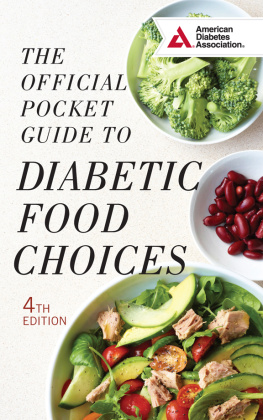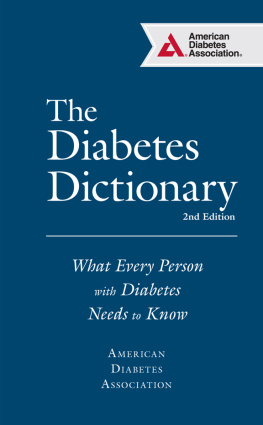 Director, Book Publishing, Rob Anthony; Managing Editor, Abe Ogden; Editor, Rebekah Renshaw; Production Manager, Melissa Sprott; Composition, ADA; Cover Design, VC Graphics; Printer: Thomson-Shore, Inc. 1999, 2007 by the American Diabetes Association, Inc. All Rights Reserved. No part of this publication may be reproduced or transmitted in any form or by any means, electronic or mechanical, including duplication, recording, or any information storage and retrieval system, without the prior written permission of the American Diabetes Association. Printed in the United States of America
Director, Book Publishing, Rob Anthony; Managing Editor, Abe Ogden; Editor, Rebekah Renshaw; Production Manager, Melissa Sprott; Composition, ADA; Cover Design, VC Graphics; Printer: Thomson-Shore, Inc. 1999, 2007 by the American Diabetes Association, Inc. All Rights Reserved. No part of this publication may be reproduced or transmitted in any form or by any means, electronic or mechanical, including duplication, recording, or any information storage and retrieval system, without the prior written permission of the American Diabetes Association. Printed in the United States of America
13 579 10 8 6 4 2 The suggestions and information contained in this publication are generally consistent with the Clinical Practice Recommendations and other policies of the American Diabetes Association, but they do not represent the policy or position of the Association or any of its boards or committees. Reasonable steps have been taken to ensure the accuracy of the information presented.
However, the American Diabetes Association cannot ensure the safety or efficacy of any product or service described in this publication. Individuals are advised to consult a physician or other appropriate health care professional before undertaking any diet or exercise program or taking any medication referred to in this publication. Professionals must use and apply their own professional judgment, experience, and training and should not rely solely on the information contained in this publication before prescribing any diet, exercise, or medication. The American Diabetes Association-its officers, directors, employees, volunteers, and members-assumes no responsibility or liability for personal or other injury, loss, or damage that may result from the suggestions or information in this publication.  The paper in this publication meets the requirements of the ANSI Standard Z39.48-1992 (permanence of paper). ADA titles may be purchased for business or promotional use or for special sales.
The paper in this publication meets the requirements of the ANSI Standard Z39.48-1992 (permanence of paper). ADA titles may be purchased for business or promotional use or for special sales.
To purchase more than 50 copies of this book at a discount, or for custom editions of this book with your logo, contact Lee Romano Sequeira, Special Sales & Promotions, at the address below, or at LRomano@diabetes.org or 703-299-2046. For all other inquiries, please call 1-800-DIABETES. American Diabetes Association
1701 North Beauregard Street
Alexandria, Virginia 22311 Library of Congress Cataloging-in-Publication Data
Geil, Patti Bazel.
Diabetes meals on $7 a day-or less / Patti Geil and Tami Ross.-2nd ed.
p. cm.
Includes bibliographical references.
ISBN-13: 978-1-58040-272-9 (alk. paper)
eISBN-13: 978-1-58040-412-9
1. 2. 2.
Low budget cookery. I. Ross, Tami. II. Title. III.
Title: Diabetes meals on seven dollars a day or less.
RC662G45 2007
641.56314dc22
2007015972 CONTENTS CHAPTERS RECIPES To Jack, Kristen, and Rachel: Your love and support is priceless! Patti B. Geil To my Mother, who instilled in me at an early age the value of a dollar. Thank you for teaching me always to spend my money wisely. Tami A. Ross Introduction
HEALTHY EATING:
A BLUE-CHIP INVESTMENT I t is just a quick trip to the supermarket to pick up a few things. You reach the checkout line and youre suddenly slammed with sticker shock. How could just a few bags of groceries cost more than $100? You know that healthy eating is vital for people with diabetes, yet once again you find yourself thinking, I cant afford to eat healthfully.
Without a doubt, diabetes is an expensive disease. One out of every 10 health care dollars spent in the United States is spent on diabetes and its complications. Family budgets must stretch to cover the costs of medications, monitoring supplies, and more frequent visits to health care providers. People with diabetes spend $13,243 annually on health care, compared to those without diabetes who spend only $2,560 each year. It is a common misconception that a healthy diabetes diet must be costly and consist of special diabetic foods and high-priced sugar-free treats. American households already spend 14 cents of every dollar of their disposable income on food.
Given the additional expenses associated with proper medical management of diabetes, revising your meal planning and shopping strategies will save you money without shortchanging your health. Investing a bit of time and money in healthy eating is a blue-chip investment for your future. Results of the Diabetes Control and Complications Trial (DCCT) showed that improving blood glucose control lowers the risk of diabetes complications-such as eye and kidney disease-in individuals with type 1 diabetes. The United Kingdom Prospective Diabetes Study (UKPDS) showed similar results in patients with type 2 diabetes. Nutrition is a key factor in helping to control your diabetes. Spending the money to eat healthfully will improve blood glucose control now and may help prevent costly complications and expensive medical care later in life.
Eating well and spending less are not mutually exclusive. In fact, healthier foods can actually save you money. Researchers have found that when families went on weight loss diets, they not only lost weight but also reduced their food budgets. The savings came from reducing portion sizes and buying fewer high-calorie, high-priced foods. If you think you must buy expensive special versions of the foods your family usually eats, think again! The American Diabetes Association nutrition recommendations simply suggest eating healthfully-the same advice that already applies to every member of your family. The nutrition guidance for people with diabetes is the same as that for anyone interested in eating healthfully.
It consists of a plate full of low-fat, high-fiber grains, beans, fruits, and vegetables with small portions of meat and protein foods and limited amounts of fats, sweets, and alcohol. Everyone should strive to eat according to these guidelines to lower the risk of heart disease, obesity, and some forms of cancer. Involve your family in your healthy eating, cost-cutting campaign. Your family-and your wallet-will thank you for it. So leave those costly diet or diabetic foods on the grocery store shelf. Hands off the high-priced sugar-free sweets.
The latest nutrition recommendations give you the freedom to enjoy small amounts of regular sugar and sweets, as long as your weight, blood glucose levels, and blood lipids remain in control. If you are used to spending significant amounts of money on artificially sweetened treats, you can use your savings to invest in another treat-like a new exercise video or a stress-free evening out on the town. SPEND LESS, EAT HEALTHFULLY Now, more than ever, eating healthfully on a budget is a challenge. When we first published Diabetes Meals on $7 a Day-or Less! in 1999, the American Farm Bureau Federation Marketbasket Survey showed that purchasing 16 basic grocery items costs $32.51. Today, those same 16 items ring up at $42.95. The good news is that you can eat a wide variety of healthy foods without breaking the bank.
The American Dietetic Association has demonstrated that a 2,000-calorie meal plan costs approximately $6.69 per person per day and only $6.33 if youre a vegetarian. You will find that the more time and effort youre willing to spend, the more money youre likely to save. For example, it may take a few extra moments to prepare quick cooking oats rather than the microwave instant version, but the trade off of time for money and good health is worth it. ATTENTION SHOPPERS! ECONOMICAL EATING IN AISLE ONE The American Dietetic Association has calculated the average daily costs to eat according to the 2005 Dietary Guidelines for Americans.
Next page













 Director, Book Publishing, Rob Anthony; Managing Editor, Abe Ogden; Editor, Rebekah Renshaw; Production Manager, Melissa Sprott; Composition, ADA; Cover Design, VC Graphics; Printer: Thomson-Shore, Inc. 1999, 2007 by the American Diabetes Association, Inc. All Rights Reserved. No part of this publication may be reproduced or transmitted in any form or by any means, electronic or mechanical, including duplication, recording, or any information storage and retrieval system, without the prior written permission of the American Diabetes Association. Printed in the United States of America
Director, Book Publishing, Rob Anthony; Managing Editor, Abe Ogden; Editor, Rebekah Renshaw; Production Manager, Melissa Sprott; Composition, ADA; Cover Design, VC Graphics; Printer: Thomson-Shore, Inc. 1999, 2007 by the American Diabetes Association, Inc. All Rights Reserved. No part of this publication may be reproduced or transmitted in any form or by any means, electronic or mechanical, including duplication, recording, or any information storage and retrieval system, without the prior written permission of the American Diabetes Association. Printed in the United States of America The paper in this publication meets the requirements of the ANSI Standard Z39.48-1992 (permanence of paper). ADA titles may be purchased for business or promotional use or for special sales.
The paper in this publication meets the requirements of the ANSI Standard Z39.48-1992 (permanence of paper). ADA titles may be purchased for business or promotional use or for special sales.